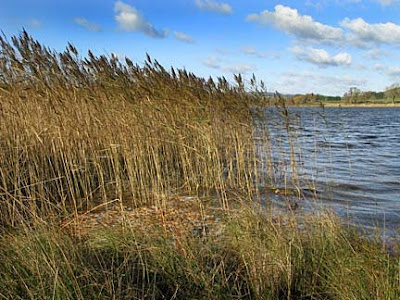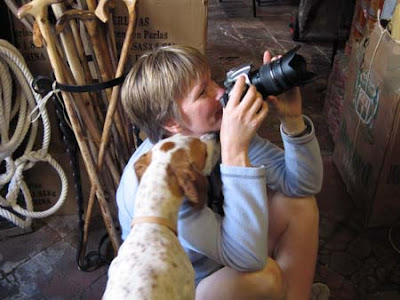Philip Dunn has moved his blog to www.photoactive.co.uk
8 Nov 2008
Philip Dunn's new blog
4 Nov 2008
Seeing photographs differently

It's been a particularly busy period with one-to-one tuition. Some photographers have come as far as Brighton in the south of England and the range of their skills and experience has been very wide-ranging: everyone from an complete beginner who brought along her new compact camera, to an experienced pro from London who wanted to learn more about using portable studio lighting on location.
The one thing that all these photographers have in common is a keenness to learn more and to get more from their photography. The other common denominator is that they all see things quite differently. I have many options for different locations here in Galloway, and I try to suit a location and subject to each photographer's particular requirements. Some, for instance want to learn more about photographing interiors, people or seascape. I simply take the photographer to the location that I believe will best suit. Even so, this means that I visit some locations more often than others - but always with different photographers.
The thing that never ceases to astound me is that each photographer will approach these subjects and photograph them in a totally different way. Yes, I know light conditions are never identical from one visit to the next, but that's not what I mean. Take Neil Murray, for instance. We went together to a part of the coast where there is an old derelict stone building. I've been their dozens of times with other photographers but none has seen it the way Neil saw it.
What was one of the first things he did? He sat in the ruined fireplace and pointed his lens up the chimney.
Okay, the picture didn't work very well, and as I watched him shooting away, I had a good idea that it wouldn't. But no way would I tell him that. Far better that he kept his enquiring eye and learnt from the ocassional failure. That way he will definitely produce something very special every now and again.
That's Neil in the photograph above
2 Nov 2008
Light and landscapes

We walked together down a wooded path which I’ve not used for over a year. This path meanders alongside the tidal river Dee through a stretch of oak and beech trees. It came as something of a surprise that, although I knew the path well and have taken many pictures here before, I was seeing things as if for the first time. New pictures were jumping out at me at almost every step. I was seeing new close-ups and different angles between the tree trunks; I noticed lovers’ initials and hearts carved in the bark of some of the trees, I photographed the sparkling water of the river, and hawthorn berries showing bright red against the deep blue sky. So why did it all look so different? The trees were the same and so was the river.
 It was all about light. That’s what was so different. It was brighter, crisper, and striking the trees and all the other subjects at different angles to the last time I was there.
It was all about light. That’s what was so different. It was brighter, crisper, and striking the trees and all the other subjects at different angles to the last time I was there.It reinforced my old theory that even though your local landscape may be very familiar to you, and you may have photographed it many times before, if you look at the same place at a different time of day, a different season and in different light conditions, it can reveal many previously unseen secrets.
Certainly my student for the day enjoyed his walk through the woods – and we took an awful lot of photographs together that lovely morning.

29 Oct 2008
Should you join a camera club?
“Should I join a camera club? How many times must I have been asked that question by my students over the years? It is usually followed by: “I’ve heard they can be a bit sniffy about welcoming newcomers like me.”
Well my answer is always the same. Yes, join. But first, go to your local club and see if you enjoy it. Only you can decide whether or not you are made to feel welcome. I do point out that it is only fair to go to at least a couple of club nights so that you get a ‘feel’ for the atmosphere. If you feel uncomfortable or unwelcome after that, just don’t bother going back again. End of problem. If you have not been put off entirely, try another club.
A very small minority of clubs really are sniffy and not worth bothering with. Most are well worth joining. Any club is really only a group of people, and, like all groups of people, there are good and bad. A good club is made up of people who are generous with their experience and knowledge – they like to share it with members who are less experienced and they enjoy learning from others.
I am often asked to talk at camera clubs and photographic societies. It’s a job a really enjoy. Some while back I was invited to speak at the Ayr Photographic Society. There was nothing sniffy about the photographers there. Just a genuine thirst for understanding and a willingness to include photographers of all levels. The club is thriving because of this inclusive attitude. There are just a few clubs whose members could learn from this openness – they are the ones, thankfully in the minority, who treat newcomers and novices with patronising distain. The strange thing is that these sniffy clubs often produce inferior photography. Their core members are far too busy being precious to open their minds and try new ideas and techniques or to help new members.
Perhaps I’ve earned the sort of reputation that means I am unacceptable to ‘sniffy’ camera clubs, because I’ve never been invited to speak at one.
27 Oct 2008
Night photography
26 Oct 2008
Becoming a professional photographer

I have several professional photographers who come to me on a regular basis - some of these travel up from London for the sort of coaching that can help keep them ahead of their game. I also get a great many amateur photographers who have ambitions to turn professional. Not all these photographers have what it takes to make it in the highly competitive world of professional photography. Jason Harry came to me full of enthusiasm and brimming with the sort of energy that just couldn't fail.
Today, just a couple of years later, Jason is chief photographer of a major studio in Manchester and has 7 photographers working under him. I'm delighted to say that Jason is among the countless numbers of my students who keep in touch regularly and the other day he sent me this photograph which he has agreed I should share with you.
This is what Jason wrote:
"Here is an image from a shoot that I did on Saturday night using rear curtain sync, two 580ex mounted on a film-type boom shooting through a big brolley, cannon don't do wireless rear curtain sync but that didn't stop me I had some custom kit made up including light sens triggers that mount on my camera 580ex and repeat shoot without having to reset the damn things and using the radio pulsar transmitters means (radio waves) they (the off camera units) can be up to 100 meters from me and still trip off - even through walls.
"The light setup on camera, boom, triggers, custom kit and two units on the boom is about £2k worth of stuff, I think it is worth the spend...
"Hope you like the resulting image, ISO 400 about 1/6 sec shutter speed and f5.6 from memory... oh and the camera hand held!!!
"The image has had some cross processing on the buss colours but apart from that it is as shot, I was taught well early on to get it right in camera as much as .... possible. All the best dude."
And to you Jason. Thanks for sharing.
22 Oct 2008
Photography Holidays in Menorca dates

We've just sorted the dates and prices for the Menorca photography holidays next year and put them on the Photoactive website.
We now get so many people wanting to come back for a second - and sometimes a third time, that we now do two different itineraries - Menorca One and Menorca Two.
- 7 nights at four star S'Algar Hotel inclusive of breakfast and dinner.
- Airport transfers in Menorca.
- Transport to locations in Menorca.
- Entrance fees where necessary
- Welcome and farewell drinks.
- NO single room supplement.
